-
Car Reviews
- Car News
-
Car Comparisons
Latest comparisons
- Chasing Deals
It might use 60 percent more fuel than the outgoing diesel, but the RS6-sourced petrol V8 brings a sense of theatre and performance like few other seven-seat SUVs
Audi has long been a champion of the diesel engine, brushing aside the usual suggestions that oil-burning motors are suitable only for family SUVs, and instead forming a habit of shoehorning its biggest and torquiest diesels into Audi Sport performance cars.
The SQ5 TDI is probably the most notable of these, and Audi’s most successful diesel performance car in Australia, but not far behind has been is the SQ7 TDI and its five-seat, coupe-shaped derivative, the SQ8 TDI.
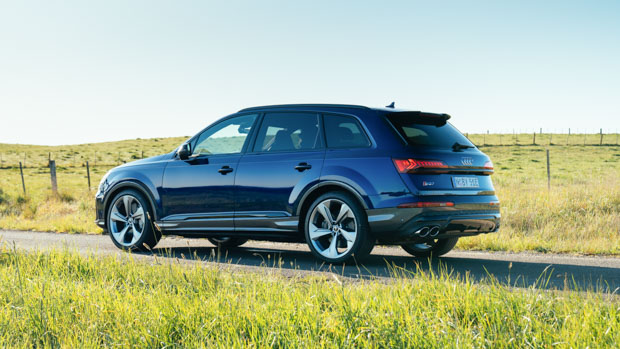
After some back and forth with a petrol dalliance, the midsize SQ5 has retained its diesel V6 engine, but the same cannot be said for the SQ7/SQ8 – which due to the discontinuation of Audi’s V8 diesel engine are now powered by a 4.0-litre twin-turbo petrol V8 shared with the halo RS6 wagon.
The decision to switch to a petrol engine in the SQ7 is part of a wider trend towards petrol and against diesel in Audi performance cars, senior product planner Matthew Dale told Chasing Cars.
While the new petrol may lose some of the inherent characteristics that made the diesel a cult favourite among Australian buyers, Dale argues the benefits in performance are worth the trade off.
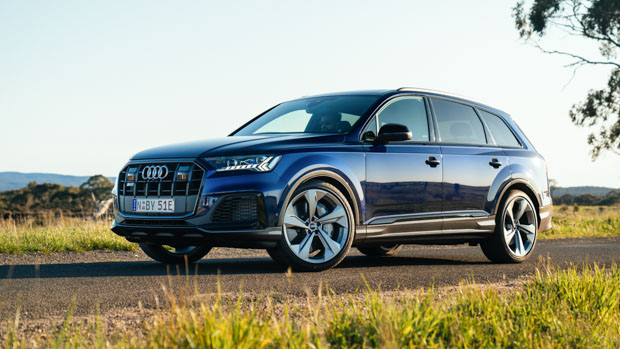
Interestingly, unlike the SQ8 model that plays second fiddle to Audi’s flagship SUV – the RSQ8 – the SQ7 represents the pinnacle of the Q7 range as there is no RSQ7 and no such model is currently on the horizon.
Priced at $164,100 the petrol-fed SQ7 is around $1700 more expensive than the diesel was in 2021, though for what it’s worth, that’s $300 less than Audi initially expected the new model’s price to be thanks to changes to the luxury car tax earlier this year.
As you would expect from a car at this price point, the SQ7 comes loaded with standard features including 22-inch wheels, rear-wheel-steering, adaptive air suspension, Matrix LED headlights, four-zone climate control, and seven seats trimmed in Valcona leather.
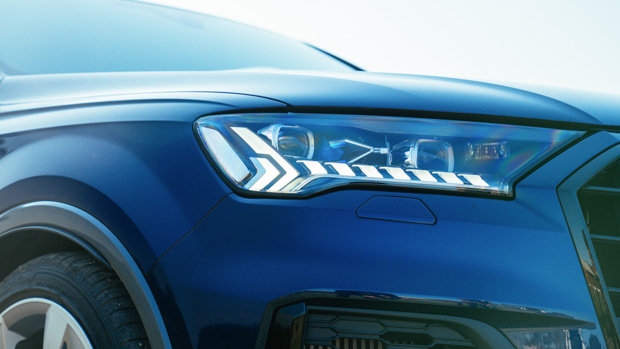
Audi also offers two key packages as options. The first is known as the sensory package ($13,300), which adds several luxury features including cooling for the front seats, heating for the second row seats, an upgraded 23-speaker Bang & Olufsen sound system, and even more leather in places like the dash and centre console.
The second is known as the dynamic package ($10,900) which makes the SQ7 handle incredibly competently for a large SUV. This pack, crucial in our view, adds a torque vectoring rear differential and a 48-volt active anti-roll bar system.
It doesn’t take long after pushing the engine-start button to recognise that the SQ7 is no longer a diesel, with the petrol petrol V8 sparking to life.
A cold start is recommended with the windows down to make the most of the V8’s crackle but once on the move the SQ7 fills the cabin with an unmistakable eight-cylinder howl. It sounds great, but it does make you wonder how much longer this kind of engine can last in an increasingly eco-conscious segment.
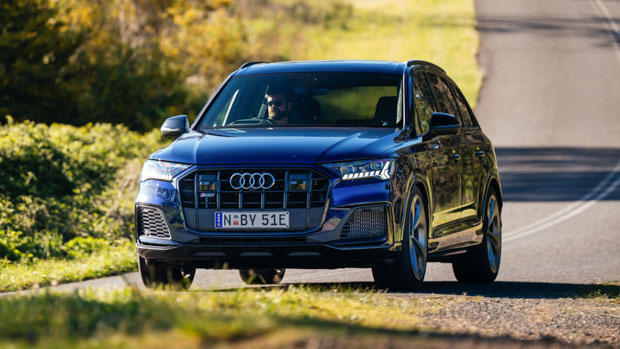
Sadly I’ve never found myself behind the wheel of the old V8 diesel-powered SQ7 but I have wielded the closely-related Volkswagen Touareg with the same engine, and I can certainly understand why buyers loved the diesel V8 so much.
However that torque-rich nature of that engine hasn’t vanished from the SQ7 in the switch to petrol power. While the ‘TFSI’ V8 may not offer the immense 900Nm torque figure of its predecessor, a 770Nm peak in the new donk is still extremely generous in a family SUV.
It also doesn’t hurt that the new petrol V8 ups the power by a not-insignificant 16 percent to 373kW, compared to 320kW in diesel guise. Plus, the power-to-weight is massively improved thanks to the petrol engine 164kW/tonne compared to 134kW/tonne in the diesel thanks to a hefy 120kg weight decrease.
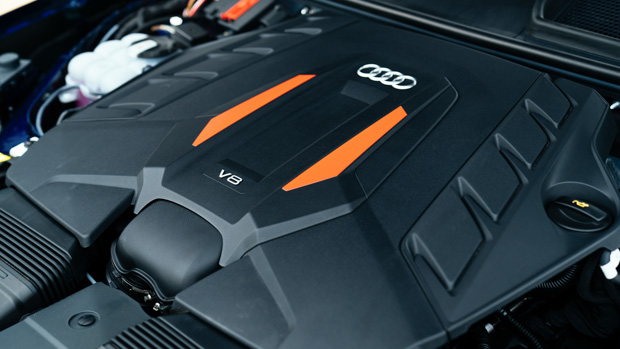
These combined gains have seen the 0-100km/h sprint time drop from 4.8 to 4.1 seconds, a fairly astonishing claim considering there are no electric motors at play here. We’ll independently test the SQ7’s 0-100km/h number soon.
Of course, you can’t just nab yourself an animal of an engine and call yourself a performance car in 2022, and surprisingly it’s in the handling department where the SQ7 really shines – though this finding comes with one very important caveat.
By default, the SQ7 rides on a more performance-oriented version of Audi’s air suspension setup which does provide the seven-seater with a fairly comfortable ride that keeps the ride smooth and forgiving, even when I was traversing some particularly savage country roads in the Victorian countryside.
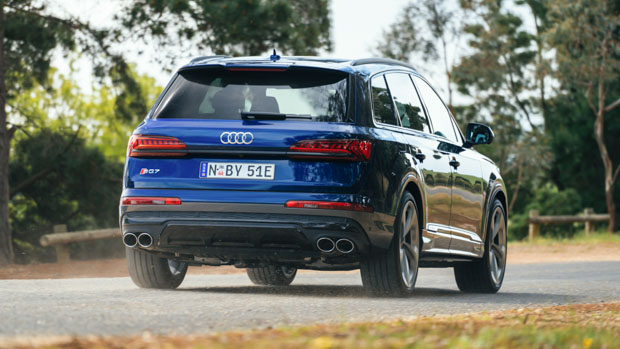
Drive the Audi at a casually brisk pace, however and you’ll quickly see this circa two-tonne, 1743mm tall behemoth start to give way to physics. This is a cue to switch to the dynamic drive mode, which firms up the suspension and increases the road-holding ability – though this does come at the expense of the ride which becomes notably harsher.
Audi offers the dynamic package for an extra $10,900, which is a lot of money for an optional extra, but its effect cannot be understated. The pack adds a torque vectoring rear differential and a 48-volt active anti-roll bars, with the latter significantly reducing sway from the body by counteracting the car’s centre of gravity with the turn.
While the latter system does go some way into making the SQ7 faster in the bends, it’s what it does to the comfort of the cabin which is the most impressive.

The always-on nature of the active anti-roll bars means those inside the cabin aren’t knocked about by rough roads and tight turns, allowing the air suspension to remain on a softer setting.
Put simply: the package allows the driver to carry more pace on a country road while being more comfortable doing so.
We haven’t yet had a chance to drive the petrol-fed SQ7 in town but the addition of standard rear-wheel steering does make it easier to wield in tight car parks. Audi says the rear axle can rotate up to five degrees, providing the seven-seat with the same 11.8m turning circle as a Q3 small SUV.
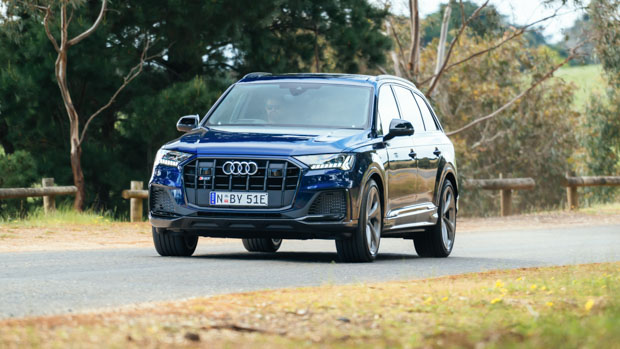
Audi offers its usual comprehensive safety suite in the SQ7, which carries an official five-star safety rating after the facelifted model was crash tested overseas in 2019.
Basic equipment includes forwards AEB with pedestrian and cyclist detection, a 360-degree camera and rear cross traffic alert. Of particular note for parents is the addition of revsering AEB and safe exit assist.
During our test, we were especially impressed with the adaptive cruise control equipped on the SQ7, which provided better foresight and a smoother lane-tracing experience when traversing country roads. Adding to the grand touring ability of the SQ7.
As par for the course with luxury SUVs nowadays, it’s hard not to notice the collection of screens dotted around the cabin but the way Audi’s designers have chosen to integrate them is less in-your-face manner than in many of the Q7’s rivals.
The most obvious is a 10.1-inch multimedia screen which features wireless Apple CarPlay and Android Auto and sits above an additional 8.6-inch unit that is designed to control vehicle functions, such as the air conditioning, and for the most part both worked as intended.
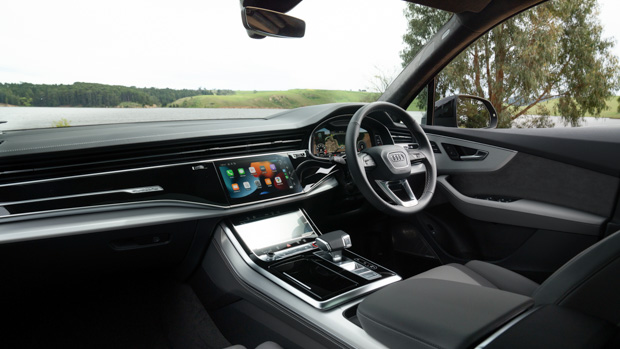
A third screen joins the fray in the form of the 12.3-inch digital driver’s display, which offers the ability to show turn-by-turn navigation and works in conjunction with a head-up display to show the driver’s speed.
Importantly, these stacked centre screens are neatly integrated into the SQ7’s dashboard, rather than sticking up above them like in some Mercedes-Benz and BMW rival vehicles.
Some of the SQ7’s haptic feedback buttons – tasked with functions such as changing drive models – were more hit-and-miss compared to the dedicated metal switches and knobs that control other tasks. The prolific use of gloss black across the dashboard and centre console is also less than ideal for those who want to keep their car clean of fingerprints.
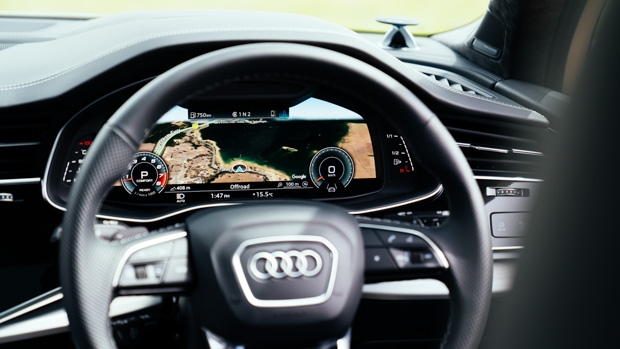
In general though, the interior quality is solid. Most surfaces feel befitting of a car at this price most and the steering wheel was a real highlight with its simple design, ergonomic shape and satisfying buttons.
The cabin is trimmed in Valcona leather seat upholstery, with comfortable front seats that features four-way lumbar support. The setup provides an ideal balance of comfort and lateral support thanks to the clever bolstering, without becoming a nuisance during egress/ingress.
Buyers can choose different leather colours including Grey-Anthracite, Black-Rock Grey and Arras Red-Anthracite.
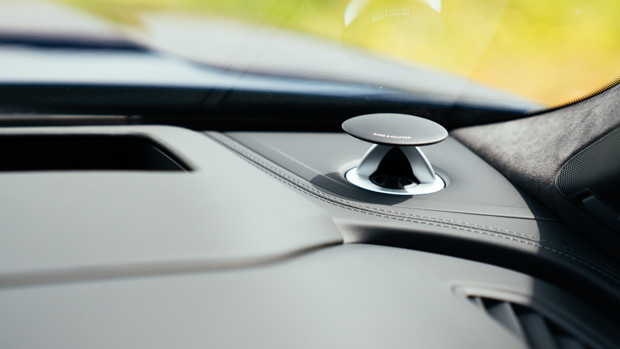
The SQ7 is fitted with heated seats as standard, with the $13,300 sensory pack adding a cooling function for the front seats and heating in the rear. Notably, the pack also adds leather on top of the dashboard and replaces hard plastics around the centre console.
These features alone may be enough for many buyers to tick this option pack on their order, but the real boon is the Bang & Olufsen sound system, which ups the speaker count from 19 to 23 speakers – including two speakers which pop up out of the dash.
The sound emerging from these speakers is very well defined and provides a fantastic sense of depth which can be played at a low volume thanks to the SQ7’s quiet cabin.
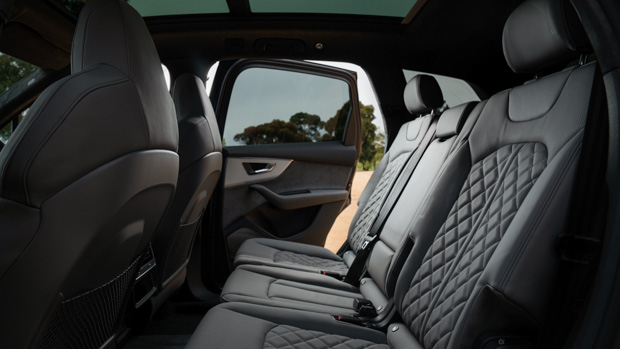
With the considerable size of the SQ7, it’s welcoming to see the second row is not just spacious, but smart too. Leg, toe and knee room are all ample and even give you enough room to move around and stretch during a long drive.
It’s worth noting that all three seats in the second row are independently slidable and benefit from four-way climate control, USB-C port for charging, a litany of air vents and even ashtrays in the doors – the latter of which hinting at the current-generation Q7’s eight-year vintage.
With the second row moved all the way forwards, climbing into the third row is relatively straight-forward revealing just enough room for my 182cm tall frame to fit, though the raised floor height means your knees sit high and the space is better suited to those of small stature.
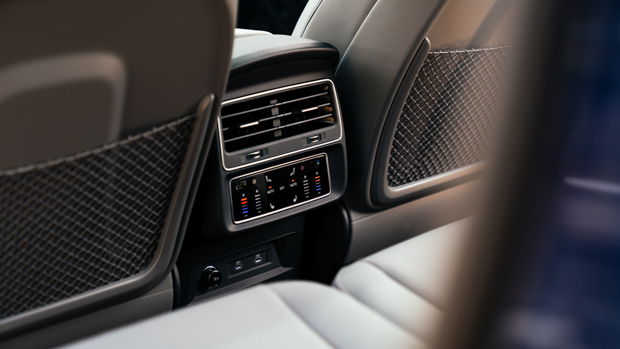
It’s notable that both the three seats in the second row and both seats in the third row are all fitted with ISOFIX points, giving owners the flexibility to seat both adults and children in comfort at the same time.
Open up the powered tailgate and you’ll find a boot which measures 295-litres with all seats in place, 617-litres with the third row folded down and a massive 1890-litres when the second and third rows are stowed away.
Sadly there is no spare wheel available in seven-seat guise, though Audi does offer a five-seat version of the SQ7 which offers a space saver spare wheel – which is apparently very popular among country buyers, and I don’t blame them.
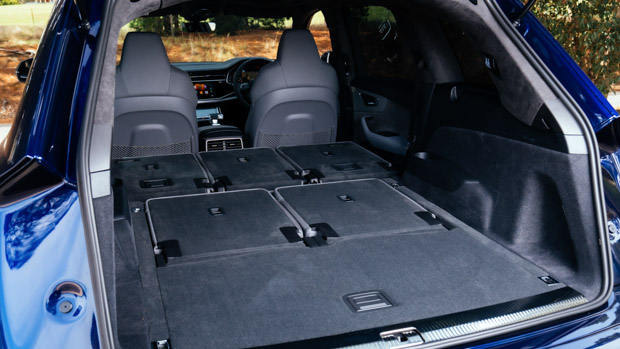
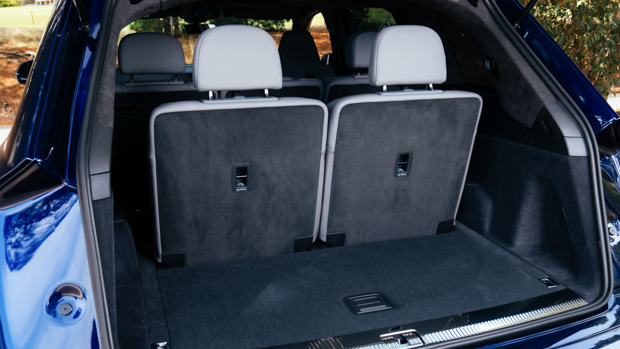
While Audi has cleverly fitted the boot with a third row capable of folding up or down at the touch of a button, owners should be careful to firstly remove the cargo cover as the two will clash if you let them.
More annoying is the fact there is no secondary position to mount the cargo blind once all three rows are in place – or even a place to stow the accessory under the boot floor.
The biggest casualty in the switch from diesel to petrol is undoubtedly fuel economy. With the new engine using an average of 12.1L/100km in combined conditions – up considerably (by 59 percent!) from the frugal 7.6L/100km consumption of the prior diesel unit.
To its credit, we did see the SQ7 stick quite close to its claim, using an average of 12.5L/100km of 98-octane fuel during a brisk few hours of grand touring and hard driving in the Victorian countryside.

Recent movements in the price of diesel, which have seen it remain considerably higher than even premium-octane petrol, may go some way to reducing the pain of the switch from TDI from a running costs perspective.
Still, this figure could be a lot worse considering the high-performance hardware under the bonnet which is required to motivate a rather large body and chassis. For context, V8-powered rivals such as the BMW X5 M50i claim 11.5L/100km and a Land Rover Defender 110 P525 requires 12.7L/100km.
However, country buyers in particular will note that the switch to petrol has significantly decreased driving range. If you go off Audi’s consumption claim, the new SQ7 TFSI can travel 702km from its 85-litre tank, compared to a long 1118km in diesel form.
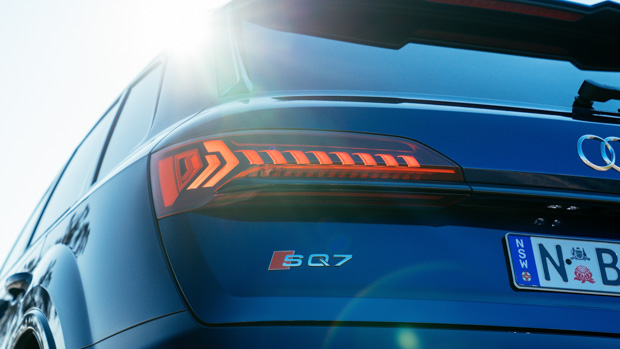
Audi doesn’t offer a capped price servicing program by default in Australia but it does offer a five-year servicing contract which will cost you $4100 up front. Servicing intervals are capped at 15,000km or every 12 months.
The recent decision to move Audi to a longer five-year, unlimited kilometre warranty is good news for buyers, drawing even with Mercedes-Benz and Lexus, and well ahead of BMW; who remains steadfast in offering just three years of coverage on its vehicles.
Australian family buyers crave cars which can do everything, and do everything well. And if there is one example which gets close to this impossible goal it has to be the SQ7.
The clear strength of the SQ7 is its duality of character; it can very easily become a monster on a neglected country-road but flick a few switches and it reverts back to a comfortable and practical seven-seat SUV which is still capable of pulling a 3500kg caravan around Australia..
It’s a slight shame that to unlock this full breadth of ability you do need to add on the pricey dynamic package but, once you do, it’s unlikely you’ll regret it.
Key specs (as tested)
About Chasing cars
Chasing Cars reviews are 100% independent.
Because we are powered by Budget Direct Insurance, we don’t receive advertising or sales revenue from car manufacturers.
We’re truly independent – giving you Australia’s best car reviews.
The estimate provided does not take into account your personal circumstances but is intended to give a general indication of the cost of insurance, in order to obtain a complete quote, please visit www.budgetdirect.com.au. Estimate includes 15%^ online discount.
^Conditions Apply
Budget Direct Insurance arranged by Auto & General Services Pty Ltd ACN 003 617 909(AGS) AFSL 241 411, for and on behalf of the insurer, Auto & General Insurance Company Limited(ABN 42 111 586 353, AFSL 285 571).Because we don’t know your financial needs, we can’t advise you if this insurance will suit you. You should consider your needs and the Product Disclosure Statement before making a decision to buy insurance. Terms and conditions apply.
Indicative quote based on assumptions including postcode , 40 year old male with no offences, licence suspensions or claims in the last 5 years, a NCD Rating 1 and no younger drivers listed. White car, driven up to 10,000kms a year, unfinanced, with no modifications, factory options and/or non-standard accessories, private use only and garaged at night.
^Online Discounts Terms & Conditions
1. Discounts apply to the premium paid for a new Budget Direct Gold Comprehensive Car Insurance, Third Party Property Only or Third Party Property, Fire & Theft Insurance policy initiated online on or after 29 March 2017. Discounts do not apply to optional Roadside Assistance.
2. Discounts do not apply to any renewal offer of insurance.
3. Discounts only apply to the insurance portion of the premium. Discounts are applied before government charges, taxes, levies and fees, including instalment processing fees (as applicable). The full extent of discounts may therefore be impacted.
4. We reserve the right to change the offer without notice.